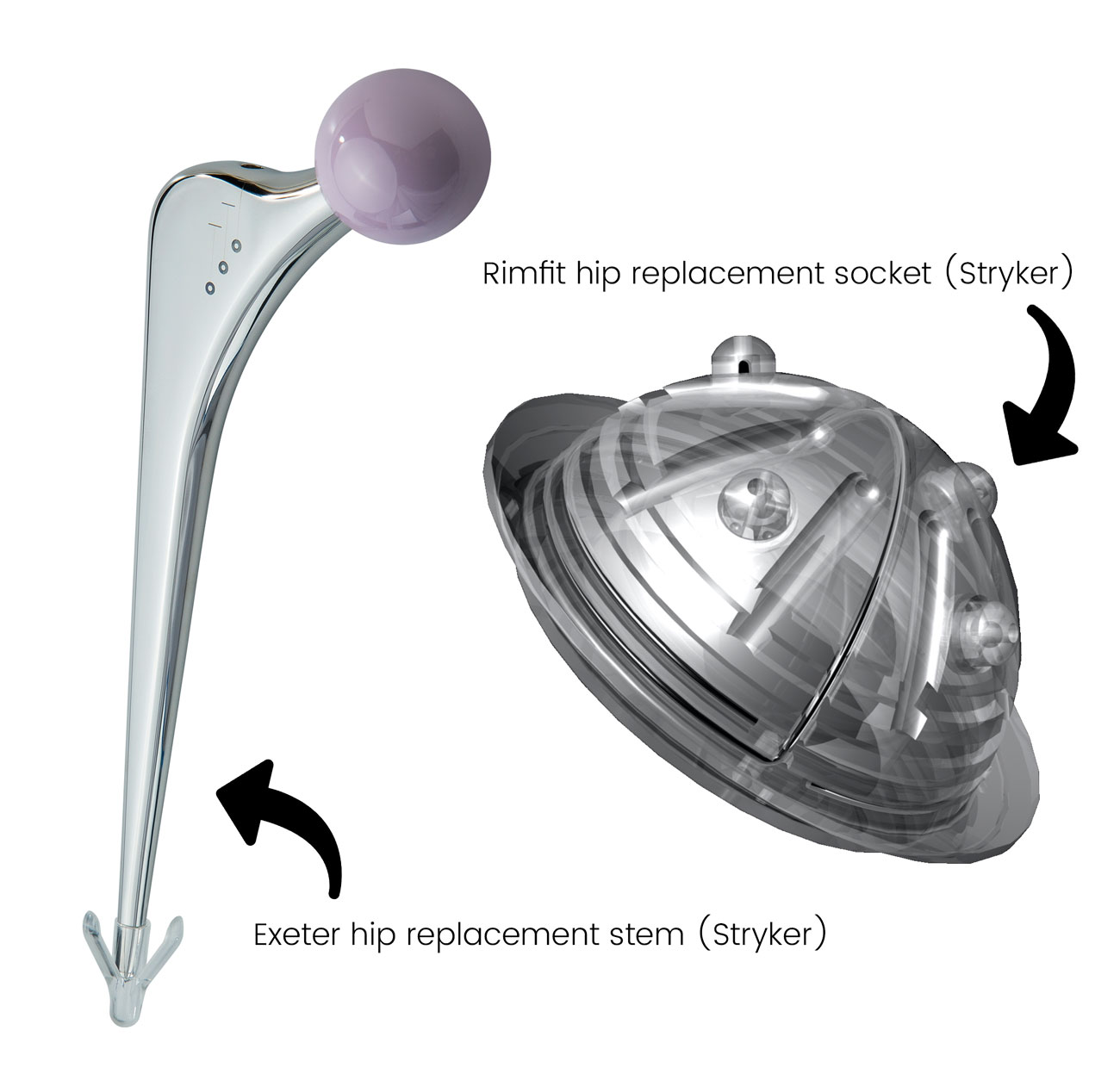Hip Replacement
Every person is an individual with a different body and different demands placed on that body.
Hip Replacement
What are the signs of needing a hip replacement?
Hip replacement surgery is all about improving quality of life and if you have severe hip pain that’s getting in the way of your ability to enjoy your everyday life, it may be time to consider surgery.
Many patients describe having a pain in the groin which is bad when sitting, getting in and out of a car, or simply walking a short distance. They may find that their sleep is disturbed at night time when they turn over in bed, or they are reliant on painkillers to get through the day.
Exercise may become very difficult, and simple activities such as putting on shoes and socks may be very challenging with a stiff hip. A painful hip can be very isolating; you may have to decline family activities, and it can even interfere in the ability to work.
If this is happening to you, hip replacement surgery can be life changing.
What happens during hip replacement surgery?
Hip replacement surgery is essentially about removing the damaged hip joint (which means removing the femoral head (aka ‘ball’), and the acetabulum (aka ‘socket’), and replacing them with man-made components. Typically a metal ‘stem’ is slotted into the top end of the thigh bone, and at its top end sits the new ‘ball’.
The old worn socket is hollowed out, and replaced with a man-made socket that articulates with the ball. The surgery is carried out through an incision through the skin, gently parting the gluteal muscles underneath, so that the worn joint can be accessed. The whole procedure takes around an hour.
 Which hip replacement type is best?
Which hip replacement type is best?
Every person is an individual with a different body and different demands placed on that body. A hip replacement needed for 50 year old ex-professional male rugby player will be different to the hip needed for a ninety year-old lady who has brittle bones. Since the first hip replacement was carried out in 1891, there have been hundreds of different kinds of hip replacement components developed.
Hip replacements are made of artificial components, and as such, they can never fully match ‘Mother Nature’, and they wear with time.
Replacement components have to be vigorously tested, and their longevity is recorded over time; we have a great deal of data about which components perform well (i.e. they have low rates of complications such as dislocation), and which components best endure the passage of time. ‘New’ might not necessarily equate to ‘better’.
I believe greatly in using tried and tested components, which is why I only use those with a proven track record. If you’re a young and active person, I’d be recommending a ceramic ball on femoral stem, which may be cemented or uncemented, and an uncemented socket with a hard-wearing plastic bearing.
If you’re into your 70’s, I’d be recommending the cemented femoral stem, with a hard-wearing plastic socket (cup) and a metal ball.
I prefer to carry out the replacement surgery through an incision at the back of the hip, known as the posterior approach; it enables the best possible access to the hip joint, with a low risk of complications.
Other more recently developed approaches (such as the ‘anterior’ approach) don’t offer any additional benefits in terms of long-term recovery, and have increased complication rates.
What’s the scar like after hip replacement surgery?
The incision for the surgery is about 4-6 inches long, depending on your body shape. I’m meticulous about making sure I achieve an excellent cosmetic result, and so I use an under the skin suture (which dissolves), and no surgical clips. I then apply a water-proof skin glue which helps reduce the risk of bleeding.
There are no stitches that need to be removed after surgery. There will of course be a scar, but this will be fine and its appearance will fade to become less visible over time.
How painful is a hip replacement?
Hip arthritis pain can be dreadful, but the moment the hip is replaced, the deep-seated, arthritis pain ends. There will be soft tissue pain (much like a big bruise), but the pain improves day by day, and is very well managed with medications. During the surgery, a short-acting spinal ‘block’ is used to numb your leg, so you will experience very little pain post-procedure.
Hip replacement complications
A total hip replacement provides excellent pain relief, improvement in function and mobility and there is a 90 to 95% chance of patients being very happy with their hip. It is one of the most successful operation one can have in terms of improving your quality of life.
Of course, as with any operation, there are potential risks involved but fortunately, such risks are usually very small compared to the benefits of having a hip replacement. It is important, however, that you are aware of these possible risks in order to make an informed decision about your care.
The risks include: infection, dislocation (where the artificial hip pops out of the socket), leg length discrepancy (where one leg may be slightly shorter or longer than the other), fracture (breaking the bone), wear and loosening (the hip replacement wears out over time), damage to nerves or blood vessels, the risk of blood clots (deep vein thrombosis) in the legs or very rarely, in the lungs (pulmonary embolus), and indeed the risk of the anaesthetic.
A great place to find out more about hip replacements can be found on the Versus Arthritis website:
https://www.versusarthritis.org/about-arthritis/treatments/surgery/hip-replacement-surgery/
The link below takes you to a great booklet all about hip replacements.
https://www.versusarthritis.org/media/23141/hip-replacement-surgery-information-booklet.pdf
How long does it take to fully recover from hip replacement surgery?
Patients are often surprised at how quickly they return to being active after hip replacement surgery. On the day of your surgery, you’ll literally be up and walking, and most people will have returned to their full levels of activity at around 3-4 months, although everyone’s rate of recovery differs a little, depending on how fit they were prior to surgery, and activity levels they wish to return to after surgery.
What can and can’t I do after having my hip replaced?
Once your hip has been replaced, it’s already very secure, and so there is usually no need for specific ‘hip precautions’ (such as needing to sit on a raised toilet seat, or not being allowed to cross your legs), however it is important to be aware that extreme positions may put your hip at risk of dislocation.
You can drive once you can safely perform an emergency stop, and get comfortably in and out of the car, and most people are back driving at around 4-6 weeks.
You may be wondering what kind of sports are possible with a replaced hip. Tennis, skiing, horse-riding, cycling and golf are all activities you could reasonably expect to return to after surgery, but high impact activities such as distance running will cause the replaced hip to wear faster, so are best avoided.
How much does a hip replacement cost?
Many patients choose to self-fund hip replacement surgery, particularly if they face a lengthy wait for NHS surgery. Hip replacement surgery typically costs in the region of £13,000. If you have medical insurance, typically hip replacement surgery will be covered, but do check with your insurer.
Should I wait until I’m older before having a hip replacement?
In the past, hip replacements didn’t last as long as they do now, and so there was a tendency in the past to encourage patients to wait until they were elderly before considering a replacement.
This meant years of suffering for some people, and now we believe it’s the need and not the age the determines whether surgery is proposed. In my own practice, the age range of my patients is typically between 60 and 90 years of age, but the youngest person I’ve carried out a hip replacement for was 19.
How long do hip replacements last?
The hip replacement components that I used in my replacement surgery have an excellent longevity record, which means that we can reasonably expect them to last at least 10 years or more, but for many patients, they may last between 15 and 20 years.
If you’ve been struggling on with hip arthritis and would like expert advice on whether hip replacement surgery would be a good option for you, please book an appointment.
Opening Hours
| Monday – Thursday | 9:00 – 17:00 |
| Friday | 9:00 – 16:00 |
At all other times, please leave a message or send an email to [email protected] and a member of the team will get back to you as the earliest opportunity.


